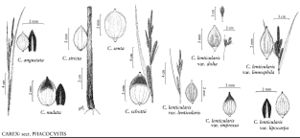Carex lenticularis var. lenticularis
Culms 8–60 cm. Leaf-blades 1.5–3.5 mm wide. Inflorescences: peduncle of proximal spike 1 cm or longer; proximal bract white at base, 2–3.5 mm wide. Spikes: proximal 3–7 spikes pistillate, 1.2–6 cm × 2–4 mm,; terminal spike usually staminate. Pistillate scales pale-brown or redbrown. Perigynia (3–) 5–7-veined on each face, ellipsoid or ovoid, 1.7–3.2 × 1–1.6 mm; stipe to 0.1–0.25 mm; beak green or pale-brown, 0.1–0.2 mm. 2n = 86–88.
Phenology: Fruiting Jul–Aug.
Habitat: Seasonally flooded river and lakeshores
Elevation: 0–1500 m
Distribution

St. Pierre and Miquelon, Alta., Man., N.B., Nfld. and Labr., N.W.T., N.S., Ont., P.E.I., Que., Sask., Maine, Mass., Mich., Minn., N.H., N.Y., Vt., Wis.
Discussion
Carex lenticularis var. lenticularis is a common shoreline species of ponds and streams in eastern North America. It can usually be distinguished from the common western taxon, var. lipocarpa, by the pale red-brown scales and lack of pigmentation on the perigynia as well as the shorter stipe; some high elevation and high latitude populations have pigmentation patterns similar to the western taxa.
Selected References
None.
Lower Taxa
"shortened" is not a number.
